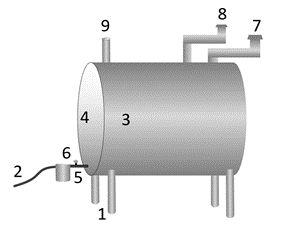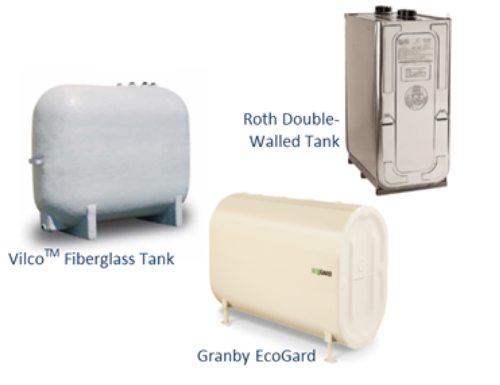Home → Waste Management → Programs → Aboveground Oil Storage Tanks → Home Heating Oil Tank Replacement Program → Is Your Tank in Shape?
I have a spill or leak! What should I do?
First, call DEP’s 24-hour spill reporting hotline: (800) 482-0777
Check Your Tank, Prevent a Leak
Spilled heating oil can pollute your drinking water and the air in your home. Keep your family safe. Check your home heating oil tank to prevent leaks.
Is your tank in danger of leaking? Answer these questions to find out.
Please look - don't touch. A rusty or oily patch on the tank could indicate a leak or weak spot. The diagram shows where to check your tank on questions 1-9. See your results below.
- Is the tank leaning, unstable, or on an unstable base? Outside vertical tanks must stand on a one piece, reinforced concrete pad. Outside horizontal tanks must stand on a one piece, reinforced concrete pad or solid concrete blocks.
- Is the piping buried underground, in concrete, or installed under a basement floor without continuous sleeving? Continuous sleeving leaves a gap between the line and the inside of the sleeve.
- Is the tank patched or showing signs of corrosion? Do you see rust, weeps, wet spots, or excessive dents on the tank surface?
- Is the tank a crimped end tank? Crimped end tanks are usually weaker than tanks with modern capped ends. Look for an obvious rim or edge (crimped), rather than a round/smooth end (capped).

NO YES
NO YES
NO YES
NO
- Does the oil exit through a fitting from the side or top of the tank rather than from the bottom? A bottom oil outlet minimizes trapped water and reduces rust inside your tank. NOTE: This does not apply to Roth Tanks.
- Are there any visible drips or signs of leakage around the filter, valves, or other fittings?
- Could the tank’s vent be clogged or blocked? Check for ice, snow, or insect nests. A blocked vent can cause a silent overfill whistle when the tank is being filled. If you’re not sure, ask your oil delivery driver.
- Are there any signs of spills around the fill pipe?
- Is the tank's gauge cracked, stuck, or frozen? Do you see oil or staining around it?
NO YES
NO YES
NO YES
NO YES
NO YES
- Is the tank made of steel and more than 25 years old?
- Can snow or ice fall on the tank, filter, or piping? A filter protector can help avoid this threat.
- Is the tank a 55-gallon drum or other container not listed for supplying oil to heating appliances?
- Is the tank no longer in use but still containing oil? Or is there a fill pipe in place for an old tank that is no longer there?
- Is your heating oil supply system not in compliance with the standards of the Maine Fuel Board? Consult a service technician as needed.
NO YES
NO YES
NO YES
NO YES
NO YES
You answered yes to one of the questions: your tank may be in danger of leaking or causing a spill.
- If you found a leak or spill, call the spill reporting hotline now – (800) 482-0777
- Call your licensed oil heat technician or local fuel supplier to schedule a checkup. Contact the Maine Fuel Board at (207) 624-8627 for help finding a licensed oil heat technician.
- If you receive fuel assistance, you may be eligible for assistance with replacing your oil tank. Contact your local Community Action Agency for more information.
On average, the Maine DEP responds to more than one spill every day from home heating oil tanks.
The top three causes:
#1 Tank Corrosion due to water and sludge build-up. A licensed oil heat technician can conduct an ultrasonic thickness test to determine steel thickness, which can indicate whether significant corrosion has occurred. Ultrasonic thickness testing is best used for tanks under 20 years old. For tanks over 20 years old, it is time to start planning for a tank replacement.
#2 Parts Failure can result from age, corrosion, and damage sustained from weather events. This includes but is not limited to rusted tank legs, unprotected filters damaged from falling ice or snow, and corroded fuel lines.
#3 Human Error spill causes include tank overfilling, improper maintenance or repair efforts, and damage to fuel lines and parts due to human activity.

*The tanks shown above are examples of newer heating tank designs. The Department of Environmental Protection does not endorse specific tank brands.
Replacing your tank?
Consider investing in a smarter and safer design. Corrosion-resistant fiberglass, double-walled, or double-bottom tank designs help prevent spills and leaks, and can save you money in clean-up costs.
Do you need help paying for a new tank?
Homeowners who meet income-eligibility requirements can receive grants and low interest loans through their local Community Action Agency (CAA). Contact your local CAA for more information.
Even if you don’t meet eligibility requirements, there may be assistance available for you. We are here to help you keep your home, family, and environment safe! Contact Racheal French 207-481-6860, for more information on these programs.